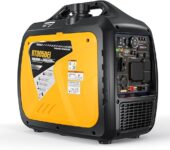
RT005DEi 5000W Portable Dual-Fuel Inverter Generator
Dual-fuel, inverter-grade power with built-in CO protection — practical for camping, RVing, and short home backups.
People who need reliable portable power know the usual trade-offs: lightweight units can struggle to run sensitive electronics for long, louder models can make campsites unpleasant, and safety — especially carbon monoxide risk — is a constant worry. When outages or overnight trips arrive, they want a compact generator that delivers clean, usable power without a lot of fuss.
The RT005DEi 5000W Portable Dual-Fuel Inverter Generator aims to address those concerns by offering inverter-grade output for electronics and CPAPs, dual-fuel flexibility (gasoline or LPG), and built-in CO protection alongside multiple start options and parallel capability. It’s a practical midrange choice that prioritizes convenience and safety, though buyers should temper expectations on noise and long-term ruggedness.
5000W Portable Dual Fuel Inverter Generator RT005DEi
This unit balances usable output, portability, and smart safety features, making it a practical choice for camping, RVing, and short-term home backup. It’s a dependable midrange inverter generator that prioritizes clean power and user convenience, though quieter and heavier-duty alternatives exist for buyers who need long continuous runtime or ultimate durability.
Top-Notch 5000W Dual-Fuel Generator: Ultra-Quiet Inverter Power Loaded
Overview
The 5000 Watts Portable Dual Fuel Inverter Generator (model RT005DEi) targets users who want more than a small 2,000–3,000 W inverter but still need something moveable for weekend trips and emergency backup. It produces peak starting watts of 5,000 and rated running watts of 3,800 on gasoline (or 4,500/3,500 on propane), and blends inverter technology with a 174cc engine to keep output stable for sensitive devices. Rather than promising commercial-grade longevity, it aims to deliver a compact, feature-rich package with safety sensors and multiple starting methods for convenience.
Key use cases include weekend campers running a small air conditioner, RVers topping up battery banks, homeowners needing temporary outage power for essentials, and tailgaters who want reliable AC for small appliances.
What’s in the box and first impressions
Included accessories—funnel, propane hose with regulator, tool kit, and the remote start battery—mean the generator arrives ready to run with minimal preparation. The unit’s footprint (about 21″ x 12″ x 20″) and the single heavy-duty molded handle keep it portable enough for one person to load into a truck or stow in an RV bay.
Performance and fuel behavior
At the heart of the unit is a 174.2 cc engine tuned to provide a stable inverter output. In real-world usage it handles medium loads—fans, lighting, TVs, small microwave or a 6,000 BTU A/C—without severe surges. The inverter stage keeps voltage and frequency clean, which is essential for laptops, phones, and CPAP machines.
Propane offers a slightly lower peak on paper (4,500W start / 3,500W run), but it’s often cleaner to store and run for longer-term standby. The small 1.8-gallon plastic gasoline tank makes gasoline runs practical for several hours (manufacturer claims up to ~7.5–9 hours at 25% load). Users should expect run time to halve or worse at higher sustained loads.
Specification snapshot
| Item | Spec |
|---|---|
| Engine displacement | 174.2 cc |
| Starting watts (gas) | 5,000 W |
| Rated watts (gas) | 3,800 W |
| Starting watts (propane) | 4,500 W |
| Rated watts (propane) | 3,500 W |
| Fuel tank | 1.8 gallons (plastic) |
| Weight | 60 lb |
| Dimensions | 20.7″ L × 11.8″ W × 20″ H |
| Special features | CO sensor, inverter output, parallel-ready |
Portability, layout, and build quality
The generator’s 60-pound weight is a trade-off: light enough for lifting by one capable person, but still substantial when moving over rough ground. The molded handle and compact casing keep it manageable. Several exterior components are plastic to save weight; most critical elements—engine block, carburetor, muffler—are metal.
Service access is straightforward: remove a few fasteners to reach the spark plug, air filter and oil fill. While the plastic fuel tank keeps weight down, some buyers looking for decade-spanning durability may prefer steel tanks and heavier frames.
Noise, runtime, and practical operation
This model is quieter than many bare-bones open-frame generators but not as whisper-quiet as premium inverter units. At low to moderate loads it stays reasonable; the engine ramps noticeably under heavy demand. If campsite quiet is a priority, plan to place it a short distance away and use an exhaust extension where allowed.
Eco mode helps extend run time and reduce noise by varying throttle to match load. The small gas tank favors short to medium stints; for extended outage coverage, propane or parallel operation with a second unit is the realistic route.
Safety systems and user controls
Safety is a strong point. The built-in CO sensor will shut the generator down if dangerous fumes accumulate, and the low-oil shutdown protects the engine. The digital panel gives immediate feedback on voltage, frequency and runtime. Overload protection is present but remember there’s no dedicated breaker that isolates the receptacles without pulling plugs—users should unplug devices before starting.
Parallel capability and expandability
Parallel ports allow pairing two identical units for significantly more peak and continuous power—handy for RVs or when adding heavier loads temporarily. The parallel path uses a dedicated cable (sold separately or included depending on the package) and can transform this midrange machine into a flexible, more capable backup system.
Maintenance and longevity
Routine tasks follow basic small-engine practice: change oil after break-in and at recommended intervals, keep the air filter clean, and use fuel stabilizer when storing gasoline. The two-year warranty is decent for this price point but shorter than some premium brands; buyers who expect heavy daily use should consider extended protection or select a heavier-duty commercial model.
Who should buy this model?
Alternatives to consider
Summary
In its category the RT005DEi strikes a sensible balance: clean inverter power, dual fuel flexibility, accessible controls, and safety features that make it approachable for non-experts. It isn’t the quietest or the most heavy-duty option available, but for most weekend and emergency scenarios it’s a compelling, well-specified choice with sensible features and good real-world performance.
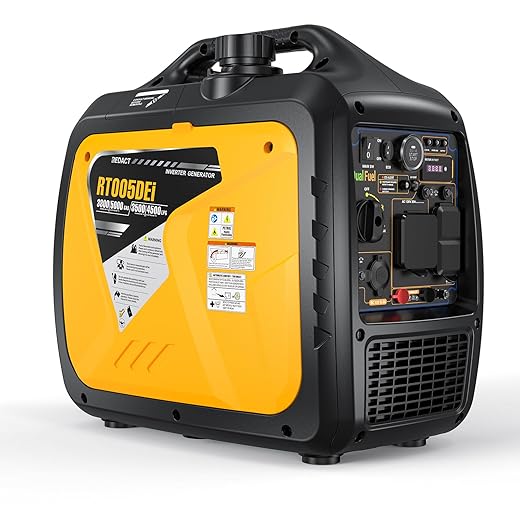
FAQ
Yes—when sized correctly. This inverter unit produces clean AC output safe for CPAP devices. For overnight use, pick the fuel (gas or propane) that gives the needed runtime; at moderate loads a night’s operation is realistic, but users should check their CPAP’s watt draw and plan for roughly 25–50% extra margin to avoid mid-night shutdowns.
Propane is usually better for long-term standby: it stores indefinitely, runs cleaner, and is easier to rotate in emergencies. Gasoline delivers slightly more starting power and is typically cheaper at the pump, but it deteriorates over months unless treated. For multi-day outages, propane or a combination of propane and parallel units tends to be least hassle.
Expect moderate noise: quieter than many open-frame portable generators but louder than top-tier quiet inverters. At light loads it’s relatively discreet; under high loads it becomes noticeably louder. For camping, place it downwind, use an exhaust extension if allowed, and keep it as far away from tents as possible to minimize disturbance.
Only if the CO sensor indicates safe conditions and the unit is placed outdoors with sufficient ventilation and clearances. Never run it inside enclosed spaces like garages or tents. The built-in CO shutdown improves safety, but proper placement and adherence to clearance guidelines remain essential.
Yes. This model is parallel-capable and can be paired with an identical unit using the proper parallel cable to combine outputs—useful when temporarily needing more continuous power for larger RV A/Cs or multiple heavy appliances.
Follow a simple schedule: check oil before each use, change oil after break-in and at regular intervals, clean/replace the air filter as needed, inspect spark plug and fuel connections, and run the generator every few months if it’s stored. Use fuel stabilizer for gasoline storage, and drain or run carburetor clean if it sits for long periods.

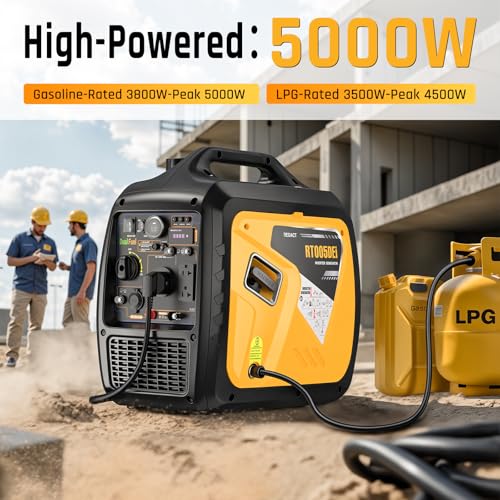
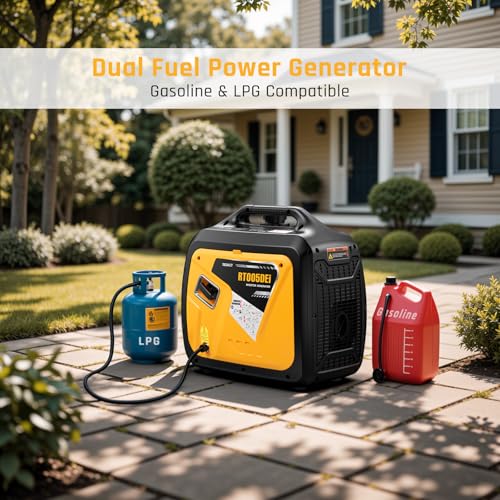
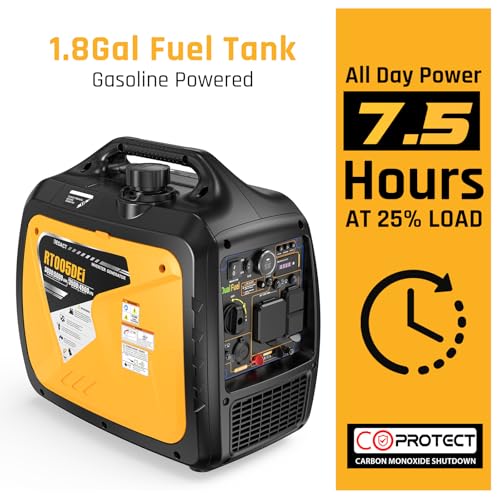




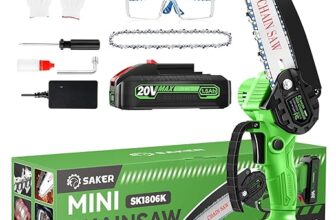

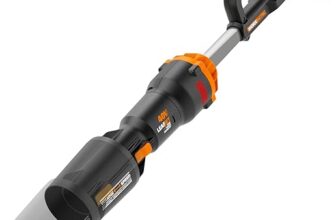

Not a fan of the price for the build quality. Feels plasticky in spots and the warranty is only one year. If you’re buying for heavy-duty home backup, there are sturdier (and possibly cheaper) options out there.
Anyone had trouble with the electric start battery dying? The package mentions a Lithium-Ion battery included — curious about longevity and replacement options.
Battery life varies with frequency of use and storage conditions. Lithium-Phosphate cells are fairly robust; if you store the unit for long periods, keep the battery charged every few months. Replacement batteries are usually available from the manufacturer or compatible 12V packs.
Mine’s been fine after a year, but I keep it on a float-style maintainer when stored. Cheap insurance against surprises.
So I almost bought this for my RV because, you know, “5000W” sounds like it could power my entire trailer and a small moon. 😅
Turns out: it’s great for AC (small ones), microwave for a minute, and charging batteries — but don’t expect to run everything at once for long.
Also: the remote start actually works. I half-expected it to be another gadget that gets left in a drawer.
Would buy again? Maybe. Would recommend for casual users and weekenders, yes.
Remote start working is such a relief — nothing worse than wrestling a recoil first thing in the morning.
Did you try the parallel feature? I’ve got a similar-sized rig and wondered if pairing two would be practical or just a hassle.
Aisha — I didn’t pair one, but the manual suggests it’s possible. Sounds handy for heavy loads but means carrying extra weight haha.
Agree on the “moon” comment lol. I fried a toaster once trying to run too much and learned the hard way.
Thanks for the candid note, Oliver. The rated running wattage is 3800 W, so people often overestimate what they can run simultaneously. Good rule: add up starting and running watts for motors (fridge, AC) before trying.
Long-ish post because I had a weird issue and thought others might benefit:
I bought this for my small cabin. First week everything was lovely, then the unit kept tripping on overload when I turned on the window AC (rated ~1400W). It wasn’t even close to the 3800W running rating. After some troubleshooting:
1) I realized the AC had a high startup surge and my combined loads pushed past the starting watt limit.
2) The generator’s display helped me identify transient overloads (nice feature).
3) I cleaned the air intake and tightened a couple of terminals — a loose connection made the surge detection worse.
So tl;dr: the generator is decent but treat the starting watt numbers seriously, and do a quick installation check (terminals, oil, filters) before relying on it. Also — tiny typo in the manual regarding torque on the battery terminal; follow the sticker on the unit instead. 🙂
Appreciate the cabin story — I’ll do a quick terminal check before my next trip. 😅
That manual typo bit me too when I installed mine. Always double-check the hardware — and bring a torque wrench if you can.
Also, check that eco mode isn’t set too aggressively; it can play with RPMs and make surges feel worse for sensitive loads.
Michael — it shows near-instantaneous values, pretty responsive. Great for seeing surges when motors start.
Excellent troubleshooting write-up, Aisha — that kind of detail is exactly what other readers need. Loose connections can absolutely cause odd trips. Thanks for pointing out the manual typo too; we’ll note that.
Good tip about the display. Does it show instantaneous watts or just averages?
Short question: how loud is this compared to other 3000–5000W generators? Planning an overnight tailgate and noise matters to us.
It’s mid-range on noise: quieter than open-frame 5000W units thanks to the inverter housing, but louder than purpose-built quiet campers’ models. Expect conversational noise at ~20–30 feet; closer it’s noticeably louder. Wind and placement also change perceived volume.